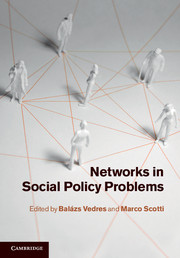Book contents
- Frontmatter
- Contents
- List of contributors
- Acknowledgements
- 1 Introduction
- Part I Information, collaboration, innovation: the creative power of networks
- Part II Influence, capture, corruption: networks perspectives on policy institutions
- 6 Modes of coordination of collective action: what actors in policy-making?
- 7 Why skewed distributions of pay for executives is the cause of much grief: puzzles and few answers (so far)
- 8 Networks of institutional capture: a case of business in the State apparatus
- 9 The social and institutional structure of corruption: some typical network configurations of corruption transactions in Hungary
- Part III Crisis, extinction, world system change: network dynamics on a large scale
- References
- Index
6 - Modes of coordination of collective action: what actors in policy-making?
from Part II - Influence, capture, corruption: networks perspectives on policy institutions
Published online by Cambridge University Press: 05 September 2012
- Frontmatter
- Contents
- List of contributors
- Acknowledgements
- 1 Introduction
- Part I Information, collaboration, innovation: the creative power of networks
- Part II Influence, capture, corruption: networks perspectives on policy institutions
- 6 Modes of coordination of collective action: what actors in policy-making?
- 7 Why skewed distributions of pay for executives is the cause of much grief: puzzles and few answers (so far)
- 8 Networks of institutional capture: a case of business in the State apparatus
- 9 The social and institutional structure of corruption: some typical network configurations of corruption transactions in Hungary
- Part III Crisis, extinction, world system change: network dynamics on a large scale
- References
- Index
Summary
Researchers interested in exploring the role played, within policy networks, by organizations representing collective and/or public interests are faced with an array of options which is as impressive as potentially confusing. They may concentrate on the organizations considered most influential in a certain policy domain (e.g. Laumann and Knoke, 1987), or they may look at the entire field of organizations operating on a certain issue or set of linked issues (e.g. Diani, 1995); they may focus on organizations that are closest to the model of the social movement (e.g. Amenta et al., 1992) or, instead, pay attention to public interest groups in the broadest sense, sometimes without even acknowledging any meaningful difference between social movement organizations and interest groups (e.g. Burstein and Linton, 2002).
While each of these strategies may offer valuable insights, it is important to be explicit regarding the types of actors whose role in policy-making we want to explore, and on the relations that they entertain to other actors with similar agendas. Although their internal structure may substantially differ, organizations representing public interests are not usually strong enough to be able to operate entirely on their own. In most cases, they are involved in some kind of alliance and cooperation with cognate organizations. Even if they operate mostly independently, they are nonetheless located within broader organizational fields. This has some important consequences for the analysis of policy networks.
Information
- Type
- Chapter
- Information
- Networks in Social Policy Problems , pp. 103 - 123Publisher: Cambridge University PressPrint publication year: 2012
Accessibility standard: Unknown
Why this information is here
This section outlines the accessibility features of this content - including support for screen readers, full keyboard navigation and high-contrast display options. This may not be relevant for you.Accessibility Information
- 1
- Cited by
